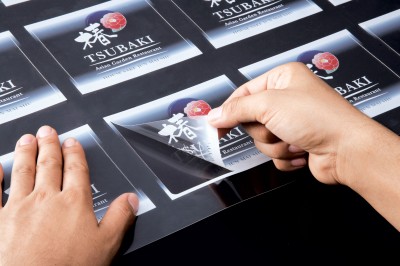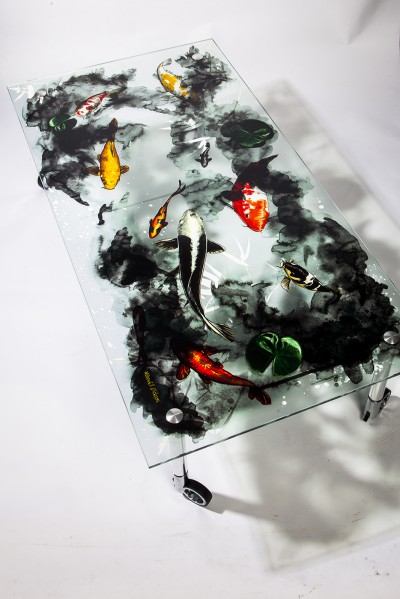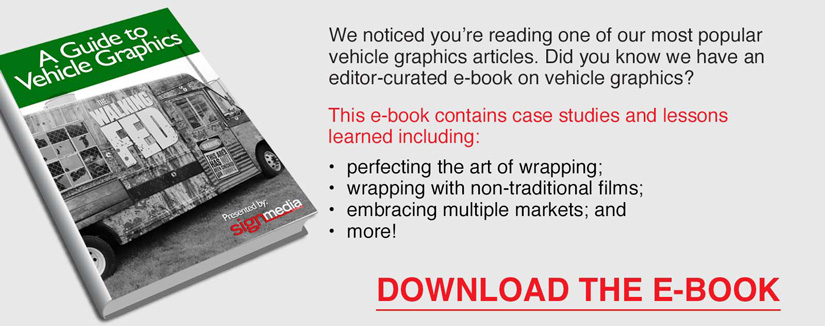Adding value with specialty inks
by all | 21 January 2014 8:30 am
 [1]
[1]Photos courtesy Roland DGA
By Laurie Weller
Ink technology in the digital printing sector has advanced dramatically in recent years, allowing print service providers (PSPs) to offer more products more profitably than ever. Indeed, one of the most significant new trends for the wide-format graphics market has been the introduction of specialty inks—including white, clear and ‘metallic’ formulations—that can add value to signs, banners, vehicle wraps, point-of-purchase (POP) displays, posters and decals, not to mention applications beyond signage, including labels, decorated apparel, packaging prototypes and advertising comprehensive layouts (also known as comps).
For those signmakers who have not already invested in wide-format digital inkjet printers equipped to handle specialty inks, now may be the right time to expand in this direction, as these inks are now mature, stable assets, suitable for use in any production environment. There is also substantial support from elsewhere in the sign industry, including software and media, which is making the inks easier to integrate into a sign shop’s existing workflow.
To take full advantage of the new generation of inks, it is important for each sign shop to determine the best production platform to serve its business model. Many ultraviolet-curing (UV-curing) printers, especially, are available with white and clear ink options, while ‘eco-solvent’ printers are fitted with white and metallic inks, among other specialty options.
Another consideration is the substrate. A flatbed model will enable direct printing onto rigid substrates for an efficient wide-format graphics workflow, while a roll-to-roll (RTR) device is well-suited for flexible vinyls, papers, banner materials, fabrics and films. Some highly versatile printers are available to help signmakers get the most output from a single investment.
 [2]
[2]Beyond signage, white ink on clear media can commonly be found in product labelling and packaging.
White ink: The must-have
Today, white ink is more than just a specialty colour—it’s an entry point to new applications, as it enables printing onto clear media, reflective surfaces and dark substrates, rather than limiting graphics to white films, boards and/or papers. As mentioned, it is available for multiple production platforms, including UV-curing and eco-solvent printers.
In addition to the elegance of a simple graphic or text, white ink can be printed as a ‘flood’ beneath four-colour graphics to help make them ‘pop’ visually.
With the diversity of output that becomes possible with white ink, a sign shop can open the door to new markets for better overall growth and profitability.
Clear media
In the sign industry, white ink is often printed onto clear media for window displays, backlit graphics and many other applications that require some level of translucency or transparency.
Metropolitan West, for example, is an interior design firm that prints white gradients directly onto clear film and then installs it into glass dividers, doors and windows for office décor. As such, white ink has become fundamental to the firm’s design approach.
Elsewhere, white ink on clear media can commonly be found in product labelling and packaging on retail store shelves. Virtuoso Graphics, for example, often relies on white ink when producing labels for high-end cosmetics products.
As plastics are incorporated into product decoration, printing onto clear substrates allows customers to see through a label to an underlying product or surface, providing more of a seamless appearance.
There are already many types of high-quality clear media on the market from a variety of suppliers, including adhesive-backed films, shrink films, polyethylene terephthalate (PET), low-density polyethylene (LDPE), polypropylene (PP) and calendered polyvinyl chloride (PVC). It is important to ensure selected materials are compatible with the printer and ink. Polyester-based substrates, for example, must have a special coating before they can accept eco-solvent inks.
Dark and reflective surfaces
Beyond clear media, the ability to print white ink onto dark or reflective surfaces is beneficial with the advent of direct-to-substrate graphics. Many new UV-curing printers, for example, are engineered to direct-print not only flat substrates, but also dimensional awards, packages and giftware, among other promotional giveaways and consumer and industrial products. White ink is even used to print logos, serial numbers and text directly onto the housing of tablet computers and other electronic devices.
Production
Working with white ink is straightforward once signmakers understand its performance characteristics.
Profiling the media, for example, is very important. Most designers think of profiles for their colour characteristics, but they also provide the balance between heat settings, ink load and production speed for the printer. Hence, the symptoms of a poor profile tend to show up as issues with drying time, opacity or adhesion.
 [3]
[3]White ink is often printed onto clear media for applications that require some level of translucency, such as glass dividers, doors and windows for interior décor projects.
Sign shops have the option of either profiling preselected media or choosing substrates that have already been profiled for the printer in question. This is why many printer manufacturers offer their own media line, designed for optimal results.
The more opaque a white ink is, the better the results. To achieve a high level of opacity and brightness, however, white ink particles are typically much heavier than those for cyan, magenta, yellow and key/black (CMYK) inks, so white ink has a tendency to settle within the printer. It thus needs to be circulated to maintain high quality.
For this reason, an automated ink circulation system is recommended for the proper management and dispersion of white ink. These systems help minimize the need for—and cost of—printer maintenance over time, while also ensuring the highest print quality across applications.
Finally, the printer’s raster image processor (RIP) software should recognize the unique properties of white ink. Compatibility in this area will make for much easier printer operation.
Clear ink: A premium finish
Clear ink has been one of the most exciting innovations for industrial printing, as it can add brilliance, texture and dimension to an ordinary graphic.
Available only for UV-curing inkjet printing devices, clear ink has been in high demand for the packaging and labelling industries, as well as for some specialty graphics. One reason for this popularity is it allows PSPs to replicate some of the most complex graphic finishes that have traditionally been generated by offset printing, but with the greater simplicity of inkjet technology.
Applications
Clear ink can be used to provide a simple matte or gloss varnish for a logo, photo or background colour; to create eye-catching reliefs and other tactile effects that encourage passersby to reach out and touch the graphic; to achieve simple embossing effects for a premium appearance; to print functional Braille dots; and to add special effects, such as faux water droplets on a champagne bottle label to simulate condensation.
Maxwell Dickson, an interior décor company, relies on clear inks when finishing the surfaces of coffee tables, which also integrate full-colour printing on tempered glass. The clear ink adds texture and durability.
Indeed, enhancing durability with clear inks is particularly important for any graphics that are handled on a regular basis, as coffee tables are, or exposed to outdoor elements.
Production
Working with clear ink is easy today. Most major graphic design software suites allow it to be integrated directly into image files.
Advances in RIP software have also made it easier to reproduce textures and patterns with precision. Some offerings include a specific pattern and texture library for clear ink, allowing signmakers to achieve reliable, repeatable results.
 [4]
[4]Clear inks can be used to add texture and durability to a wide-format graphic, as with this tempered glass coffee table.
Metallic ink: It sells
The number of sign shops using metallic inks in printing is growing at a fast rate, as the value and impact of metallic effects are quite strong. To be effective, after all, signs, POP displays, promotional graphics and labels all need to grab a consumer’s attention right away.
Metallic inks, more than any other specialty formulations, achieve this effect. In addition to gold, silver and bronze hues, it is possible to combine metallic silver ink with CMYK inks for a nearly unlimited number of metallic colours and pearlescent effects.
Applications
Metallic inks adhere to both coated and uncoated substrates, including PVC and PET films and photographic papers, to name a few. Calgary-based 54blue is a large-format printing shop that incorporates both metallic and white inks in window graphics for a variety of sports retailers.
Beyond the large-format arena, however, there are also mostly untapped markets for metallic inkjet printing in areas like proofing and package prototyping. In the past, packaging prototypes could only be produced on large presses that were expensive to operate. With digital inkjet technology, on the other hand, it is now possible to print a proof or prototype with metallic inks on demand with one standard device.
Metallic design proofs are also becoming more common because colour management software developers have integrated their technologies with wide-format printers. This allows PSPs to enjoy all of the benefits of metallic colour matching without having to invest in larger, costlier equipment.
Production
There are a number of technical factors to consider before adopting metallic inks. Like white inks, their particles are heavier than those in CMYK inks and require frequent circulation.
Metallic inks are also generally less scratch-resistant than CMYK, white or clear inks. To address this issue—and, for that matter, to create new colours—metallic inks are typically combined with CMYK inks, rather than printed in isolation. Lamination is also recommended to help make images last longer. It is a good idea to test the media in advance to ensure the results are as expected.
Again, many major graphic design software suites now allow for metallic colours in their files and RIP software offers colour libraries with hundreds of metallic options that can be matched and reproduced with high accuracy. Signmakers can even create their own custom colours.
Costs
Many PSPs worry about the expense of metallic inks. They do cost more than CMYK inks ounce for ounce, but less is needed to make the same visual impact. The old adage, ‘less is more,’ holds true.
Only if they are used to cover an entire background is their cost going to hurt, but that is the exception, not the rule. Metallic inks are hardly ever used as a flood. Typically, they cover just a small fraction of an overall graphic, adding pennies to its cost, not dollars. Operational costs for most applications tend to average less than 50 cents per square foot.
Meanwhile, the resulting graphics can command premium prices in the marketplace. They are often priced 30 to 40 per cent higher than CMYK-only prints.
 [5]
[5]Clear inks are also used to add texture to the housing for computers and other electronic devices.
Learn to teach
The advantages of specialty inks are highly evident. They help PSPs increase their value proposition for the customer, differentiate their business from their competitors and increase their profits per job.
As these inks are still relatively new to wide-format digital printing, however, customers may not already have graphic design files that incorporate them. Instead, signmakers will need to introduce the concept, with samples on hand to show off the benefits. And they will need to be ready to add special colours and effects to their customers’ files for them.
With this in mind, professional training is important. By participating in workshops and webinars, reading articles and documentation and watching video tutorials, signmakers can make the most of their investment and effectively sell their customers on new ideas. Training may come from the printer manufacturer, the ink supplier, support staff, dealers, other sign shops, user forums and/or industry conferences.
In the end, learning how best to exploit the initial investment in printing equipment and consumables will make all of the difference to the business. The shop and its customers will both benefit from high-impact results.
Laurie Weller is a writer and public relations (PR) representative for Roland DGA, which markets digital wide-format inkjet printers and cutters with white, clear and metallic inks. For more information, visit www.rolanddga.com[6].
- [Image]: http://www.signmedia.ca/wp-content/uploads/2014/01/VS-640i_front_w-BW-f843A0B.jpg
- [Image]: http://www.signmedia.ca/wp-content/uploads/2014/01/printcut_image_medRes.jpg
- [Image]: http://www.signmedia.ca/wp-content/uploads/2014/01/Metropolitan-West-Open-X-SGIA-2013-Golden-Image-Award-Winner.jpg
- [Image]: http://www.signmedia.ca/wp-content/uploads/2014/01/Maxwell-Dickson-Koi-Coffee-Table-SGIA-2013-Golden-Image-Award-Winner.jpg
- [Image]: http://www.signmedia.ca/wp-content/uploads/2014/01/Laptop_Texture.jpg
- www.rolanddga.com: http://www.rolanddga.com
Source URL: https://www.signmedia.ca/adding-value-with-specialty-inks/

